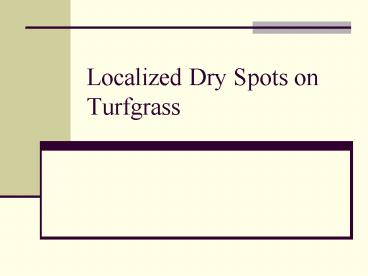Localized Dry Spots on Turfgrass - PowerPoint PPT Presentation
1 / 16
Title:
Localized Dry Spots on Turfgrass
Description:
LDS may also occur on mineral soils ... Primer 604 significantly improved water retention in soils with LDS ... LDS ... – PowerPoint PPT presentation
Number of Views:185
Avg rating:3.0/5.0
Title: Localized Dry Spots on Turfgrass
1
Localized Dry Spots on Turfgrass
2
What is a Localized Dry Spot?
- Localized Dry Spots hot spots, isolated dry
spots - Soils which have become water repellent
- Most common in high sand situations like USGA
greens and similarly constructed areas - LDS may also occur on mineral soils
3
From http//www.agcsa.com.au/atm/articles/vol46/d
ryspot.htm
4
Coated vs. non-coated soil
From http//www.agcsa.com.au/atm/articles/vol46/d
ryspot.htm
5
What is a Localized Dry Spot?
- Causes
- microbial decomposition of organic substances
(peat, roots, shoots) - Fungal activity and frequent wet-to-dry cycles,
- can produce a wax-like and water repellent
coating on sand particles. (Leinauer 2002)
6
LDS incitants
- Hydrophobic materials may include
- accumulated plant-derived organic matter (thatch,
decomposing roots, decomposing plant tissues, and
root exudates) - plant-derived waxes and organic acids
- fungal hyphae
- microbial organic acids and polysaccharides
(Kostka 2000)
7
LDS
- Studies of two wetting agents Primer 604 and
Midorich to combat LDS were performed recently - Primer 604 significantly improved water retention
in soils with LDS - Midorich did not significantly improve water
retention in soils with LDS - http//www.uoguelph.ca/GTI/99anrep/99r_4.pdf
- http//www.paceturf.org/index.php
8
(No Transcript)
9
LDS
- It was suggested by the researchers that
increased water retention following treatment
with wetting agents was due to - 1) Greater retention of fine soil particles in
the root zone - 2) A hydrophilic coating on the soil particle
created by the wetting agent
10
(No Transcript)
11
Wetting agent studies
- http//www.gcsaa.org/GCM/2005/aug05/PDFs/071-083_W
ettingAgent.pdf - http//www.eifg.org/focus/research/wetting_agents/
index.asp
12
LDS
- In another study researchers looked at the
wetting agents Respond and Primer in combination
with the fungicides Heritage and Prostar. - The fungus Agrocybe pediades (as well as other
basidiomycetes) has been found in association
with LDS and fairy ring
13
LDS
- Heritage Respond and Prostar Respond provided
the best management of LDS and fairy ring (Type B
and C) - Type B fairy rings generally cause little damage
due to hydrophobic conditions while type C fairy
rings cause extensive damage - Respond or Primer both managed LDS and type C
fairy ring when combined with fungicides in this
study
14
Type C fairy ring- from http//www.interactiveturf
.com/pest/20020715_Fairy_ring_LDS.htmPhoto5
15
From http//www.interactiveturf.com/pest/20020715
_Fairy_ring_LDS.htmPhoto5
16
References
- Kostka, S.J. 2000. Amelioration of water
repellency in highly managed soils and
enhancement of turfgrass performance through the
systematic application of surfactants. Journal of
Hydrology 231-232359-368. - Leinauer, B. 2002. Wetting agents and their
impact on water retention of turfgrass root
zones. Australian Turfgrass Management Volume
4.1.































